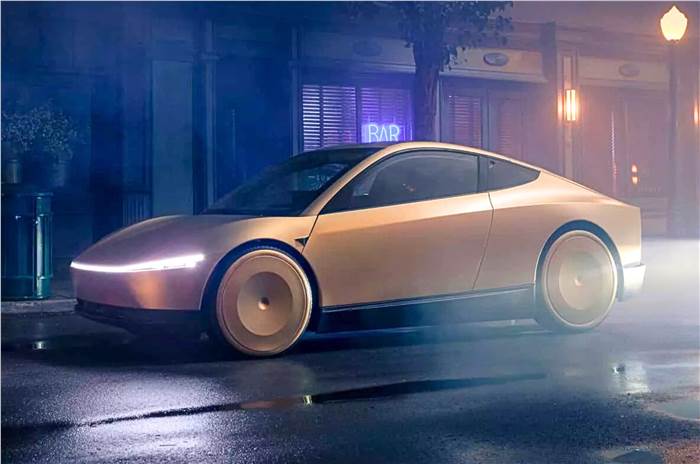Tesla has once again pushed the boundaries of autonomous driving with the unveiling of the Tesla Cybercab, a futuristic electric vehicle that represents a bold leap into the world of driverless transportation. Revealed at the highly anticipated “We, Robot” event in Burbank, California, this prototype marks Tesla’s entry into the competitive robotaxi market, currently dominated by Alphabet’s Waymo. What sets the Cybercab apart? It’s the fact that this EV has no steering wheel, no pedals, and relies entirely on Full Self-Driving (FSD) technology. Elon Musk’s vision of a fully autonomous future seems closer than ever.
Tesla Cybercab: A Glimpse Into the Driverless Future
The Tesla Cybercab is designed with a clear mission—to revolutionize urban transport and take autonomy to the next level. Musk’s long-term vision of a world where cars drive themselves is embodied in this sleek, futuristic vehicle. Unlike Tesla’s other flagship models like the Cybertruck, Model 3, and Model S, the Cybercab has completely removed manual driving controls, offering a glimpse of what a steering wheel-free future might look like.
Instead, the Cybercab is equipped with AI-driven systems, leveraging Tesla’s FSD (Full Self-Driving) software and Advanced Driver Assistance System (ADAS) Level-2 technology. This combination of cameras, sensors, and AI will allow the Cybercab to navigate streets autonomously, aiming to bring the world closer to a driverless future.
Striking Design and Features
The Cybercab’s design is as eye-catching as it is innovative. The EV features a sleek, coupe-like two-door design with signature butterfly doors, making a bold statement. Its minimalist interior strips away the traditional controls you’d expect to find in a vehicle. A large touchscreen display dominates the center console, which, much like Tesla’s other models, controls most of the vehicle’s functions. In keeping with the Tesla aesthetic, there are no visible buttons, and single LED strips run along the front and rear, giving the Cybercab a futuristic, polished look. The vehicle’s sloping roofline clearly takes inspiration from the Cybertruck, blending sharp design with aerodynamic efficiency.
One major difference between the Cybercab and Tesla’s other vehicles is the introduction of inductive charging. This cutting-edge technology enables wireless charging through electromagnetic induction, eliminating the need for plug-in stations and further enhancing the vehicle’s futuristic appeal.
Affordability and Operating Costs
While many of the Cybercab’s technical specs—such as range and powertrain—weren’t fully revealed, Musk did offer a tantalizing detail: the price. The Cybercab is expected to be priced under $30,000 (roughly ₹25 lakh), making it a potentially affordable option in the robotaxi market. Additionally, Musk hinted at an incredibly low operating cost of just $0.20 per mile (approximately ₹17), positioning the Cybercab as a cost-effective alternative for autonomous ride-sharing services.
Production for the Cybercab is anticipated to begin in 2026, with Tesla promising that it will disrupt not only the car industry but also public transportation, offering affordable, autonomous commuting for all.
Tesla’s Expanding Autonomous Lineup: Robovan and Beyond
Musk also unveiled a new concept vehicle at the event—a Robovan, a massive 20-seater designed for shared, low-cost transport. While the Robovan was only briefly discussed, it represents Tesla’s continued push into mass transit solutions. Like the Cybercab, the Robovan could revolutionize public transport by reducing costs and improving efficiency, all without a driver.
Updates to Tesla Model 3 and Model Y
Alongside the futuristic Cybercab and Robovan, Musk shared updates on Tesla’s current lineup, promising that fully autonomous driving will be available for the Model 3 and Model Y in California and Texas by 2025. As Tesla continues to refine its FSD software, these vehicles could soon be operating without human intervention in select regions, further cementing Tesla’s position as a leader in autonomous driving technology.
Final Thoughts: A New Era for Tesla and Autonomous Vehicles
The unveiling of the Tesla Cybercab represents a pivotal moment not just for Tesla but for the future of urban mobility. With its fully autonomous capabilities, affordable price tag, and futuristic design, the Cybercab could redefine how we think about transportation. As robotaxi services like Waymo continue to expand, Tesla’s entry into this space signals that the competition is about to heat up.
While we’ll have to wait until 2026 to see the Cybercab on the streets, Tesla’s vision of a driverless future seems more tangible than ever. One thing is clear—Musk’s Tesla is on a mission to make autonomous driving not just a luxury but a mainstream reality.


